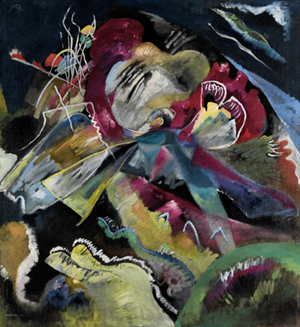
A Visual Symphony that Marks a Crucial Moment in 20th Century Art Appears at Auction for the First Time.
Hailing from a landmark moment in Kandinsky’s mastery of abstraction, Bild mit weissen Linien reveals the artist’s discovery that colour, when disassociated from representational concerns, could become the principal subject of a painting. It is a powerful masterpiece that encapsulates Kandinsky’s innovation and invention in the revolutionary year of 1913, crucial within the history of modern art as it was marked by events and works across Europe and America that fundamentally changed the way art was conceived and understood. Early in his career, Kandinsky recognised that he was moving towards something that would drastically transform the landscape of modern art, writing in a letter of 1904 to his companion Gabriele Münter “without exaggerating, I can say that, should I succeed in this task, I will be showing a new, beautiful path for painting susceptible to infinite development. I am on a new track… which will be recognised, sooner or later’. This was a quest that he accomplished in 1913 when he finally achieved abstraction in a uniquely pure, lyrical form.
Executed on a grand scale and in dazzling colours, this painting was prized highly by the artist himself and boasts an impressive early exhibition history. Never offered at auction before, it will be offered as part of Sotheby’s Impressionist & Modern Art Evening Sale with an estimate in excess of $35 million.
Created in the same year as the important Kompositions VI and VII, Bild mit weissen Linien achieves a synthesis of both ‘absolute’ paintings whilst also being a unique composition in its own right. During this period, Kandinsky took his cue from the language of musical composition – determined that every colour corresponded with a particular emotion or ‘sound’. For example, mid-green sounded like the quiet, mid-range tones of a violin, whilst yellow-green was perceived to be the higher notes of the violin, in contrast to blue-green as a muted alto-violin. However, still evident in the work are the motifs based in the romantic vision of ‘Old Russia’ and folk stories that bewitched him from the beginning of his career. Two preparatory watercolours reveal how he took a tall-towered city, two horses and a red bridge and distilled these in the final work with iridescent patches of colour and sweeping lines. Thus, the work is vital to understanding Kandinsky’s concept of abstraction which would influence the development of painting during the 20th century.
In December 1914, the year after this work was painted, Kandinsky returned to Moscow after having resided in Germany for almost twenty years. The onset of war in Europe had threatened his way of life and when Germany declared war on Russia, Kandinsky was forced to leave the country he had adopted as his artistic homeland. Having first been exhibited in Germany 1913, Bild mit weissen Linien was what Kandinsky wanted people to see in order to propagate his art and his ideas in his homeland – chosen by him to show in Odessa and Moscow in a landmark exhibition in 1915. Over the next four years, the artist witnessed the Revolution and the rise of Communism as an essentially apolitical being, whose art would ostensibly remain unaffected by the social situation. However, he swiftly became involved in the organisation of national arts as a member of the Department of Visual Arts in the People’s Commissariat of Enlightenment and a founding member of the Institute of Artistic Culture. His role, alongside a committee comprised entirely of artists including Rodchenko and Tatlin, was to select pictures for the state to send to museums in order to guide and foster an appreciation of art. This painting was allocated initially to the museum in Penza in 1920, returning to the Tretyakov Gallery in Moscow where it remained until 1974 when it was acquired by a private collector.
Kandinsky’s art had a profound impact on the artists of the Russian avant-garde, from Constructivism to Suprematism, through to the Abstract Expressionists of post-war America and beyond to artistic production today.

ArtDependence Magazine is an international magazine covering all spheres of contemporary art, as well as modern and classical art.
ArtDependence features the latest art news, highlighting interviews with today’s most influential artists, galleries, curators, collectors, fair directors and individuals at the axis of the arts.
The magazine also covers series of articles and reviews on critical art events, new publications and other foremost happenings in the art world.
If you would like to submit events or editorial content to ArtDependence Magazine, please feel free to reach the magazine via the contact page.